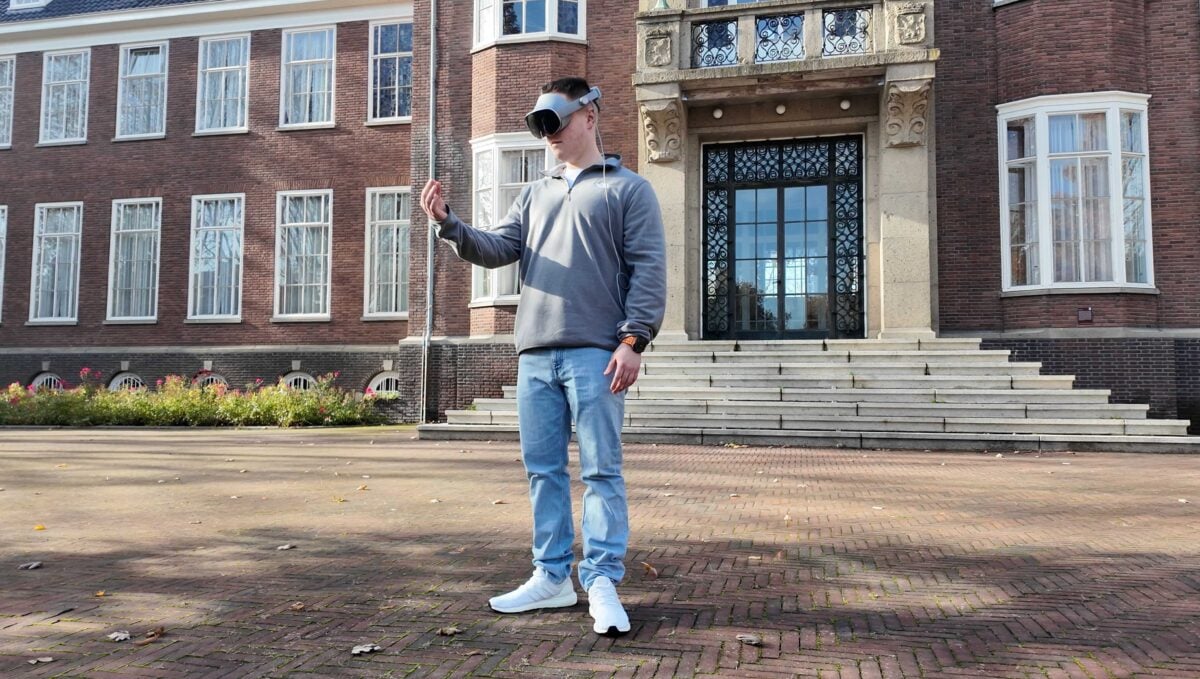Samsung has officially entered the mixed reality game with the Galaxy XR, and I finally had the chance to try it out. Here are my first impressions of Samsung’s brand-new headset and its biggest competitor to the Apple Vision Pro.
A futuristic skiing mask design that’s lighter than expected
The Galaxy XR immediately feels like a premium device. Its design looks like a futuristic skiing mask, and it is much lighter and better balanced on the head than I expected. I was a bit skeptical about comfort at first, as anyone would be. But after some testing, it turned out to be surprisingly pleasant to wear.
After a while, though, you do start to feel some pressure on your forehead, so short breaks are definitely recommended. Slightly annoying but necessary is the cable connected to the external battery pack, which you can tuck into your pocket.
Using the Galaxy XR is unlike anything I have tried before. You control everything with your eyes and hands: look at an object to highlight it, pinch your thumb and index finger to select, wave your hand to scroll, or move your hands closer or farther apart to zoom in and out.

To open the main menu, you simply pinch your fingers with your palm facing you. It takes a few minutes to get used to, but once you do, it feels surprisingly natural and far more intuitive than using controllers. If you prefer, Samsung also offers first-party controllers for around 250 dollars.
Software is a major differentiator from the Apple Vision Pro
What separates the Galaxy XR from Apple’s Vision Pro is not only its lighter weight and different design but also its software. Samsung’s headset runs on Android XR, a new operating system that feels familiar to anyone who has used a Galaxy smartphone. The interface, settings, and quick access menus all look similar, and most of your favorite apps are available as well.

Unlike the Vision Pro, the Galaxy XR has full access to the Google Play Store. You can download practically anything you like, including Netflix, Amazon Prime Video, X, Telegram or games. These apps do not need to be developed specifically for the headset, and they appear in a similar format as they would on a Galaxy phone or tablet.
Under the hood, the Galaxy XR is powered by Qualcomm’s Snapdragon XR2+ Gen 2, the same chip found in other high-end headsets. In my hands-on experience, performance was rock solid with no bugs, frame drops or stutters.
Everything, including the eye tracking, felt fast and fluid whether switching between apps, watching videos or exploring 3D environments. It is simply incredible to fly through cities like New York, browse the web on a giant floating screen or watch movies on a massive cinema-sized virtual display.


Sound quality is another strong point. The built-in speakers are surprisingly loud and clear, offering spatial audio that adjusts to your head movements. Voices sound crisp, and when watching a movie, the stereo separation adds a sense of depth that really enhances immersion. Of course, if you want to isolate yourself completely, you can connect Galaxy Buds for an even more focused experience.
Google’s Gemini and Circle to Search handle AI duties
One of the most impressive aspects is the passthrough experience. Two high-resolution external cameras let you see your surroundings in real time with great clarity, making sure you are never completely cut off from reality. A quick double tap on the frame toggles between the real-world view and full immersion. Whether standing on a mountain peak or in the middle of a desert, the transition feels instant and seamless.

This is also where Samsung differentiates itself from Apple. The Galaxy XR integrates Google Gemini and Circle to Search directly into the experience. By holding the virtual home button a bit longer, you can activate Circle to Search, look at an object, draw a circle in mid-air, and get AI-generated information right before your eyes.
It is not just cool, it is genuinely useful. With Gemini, you can rearrange your virtual workspace or get live assistance for things like recipes, productivity tasks or entertainment suggestions, all without holding a device in your hand.

Samsung claims the 36 Wh battery lasts around two hours during general use or about two and a half hours for video playback. And from my short testing, that seems accurate. If you are stationary, you can plug in the battery pack for continuous use. Since the headset eventually becomes a bit uncomfortable to wear over longer periods anyway, it makes sense to use those breaks to recharge both yourself and the device.
Galaxy XR leaves a strong first impression
At the moment, the Galaxy XR is available only in the United States and South Korea. However, Samsung plans to expand availability to more markets, including Germany, France, Canada and the United Kingdom, by 2026.
The Galaxy XR left a very strong first impression. It combines premium hardware, intuitive controls, solid performance and smart integration with Android and Google’s AI tools. The display quality, spatial audio and impressive passthrough make it one of the most convincing headsets I have used so far.
Comfort could do with improvements, and the battery cable can get in the way. But for Samsung’s first step into mixed reality the Galaxy XR is surprisingly refined. If this is just the beginning, Apple might finally have some real competition in the XR space.

